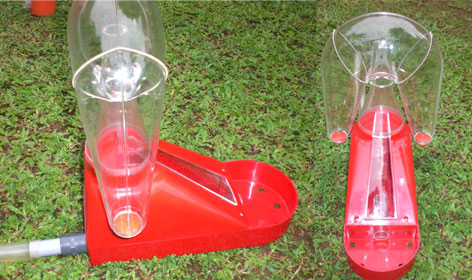Solar Mosquito Destroyer
Conventionally, mosquitoes are repelled/killed using the chemicals or killed by the electric shock. These chemicals are not good for health and electric shock is dangerous.
The main specialty of this device is its scientific and eco friendly nature that makes it different from other machines. The strategy used in this machine is making obstructions for the reproduction of Mosquitoes. Hawker indirectly destroys 45000 mosquitoes by simply killing one single female Mosquito. Hawker is the most effective way to combat your existing Mosquito problem without any application of pesticides or chemicals. Thus, it helps to avoid the use of insect repellents that contain the toxic Allethrin.
Mathews K Mathew (45) has come up with a very interesting device- the solar mosquito trapper cum destroyer. This device makes use of the smell from the septic tank to attract the mosquitoes. Once the mosquitoes get trapped inside the device, the heat built up inside the device, as a result of direct sunlight exposure, kills them.
Mathews K Mathew, alias Mathews Kaitholil, hails from Kalaketty in Kottayam district, Kerala. Since childhood and schooldays, he has been a keen lover of nature and built and spent many busy afternoons developing traps to capture rodents and small animals, making wooden toys for his friends and designing firecrackers fixed to arrows, which would explode on impact and drive away birds from picking on the harvest in farms.
After his final year of graduation, he spent more than a decade developing and refining an effective product for trapping and killing mosquitoes. Currently, he is the managing partner of the firm, Kine Technologies and Research India, based at Kanjirapally, Kottayam. Along with his two partners, his firm is involved in design, production and sale of solar mosquito destroyer. It is apt that this innovation has been done in Kottayam as it is the first town in India selected by the Ministry of Environment and Forests, Government of India to be transformed as an Eco City. It is a town located in central Kerala and is an important trading center of spices and commercial crops, especially rubber. It is famous for its panoramic backwater stretches, lush paddy fields, and highlands.
Mathew’s grandfather and uncles had migrated to Kottayam some 100 years ago and had started the cultivation of rubber, coffee, coconut, pepper and other cash crops. His father, K J Mathew was also a farmer. His family members believe that Mathew has inherited his innovative streak from his grandfather who was versatile and had built all his household furniture, agricultural implements and contraptions to collect honeybee and modified and serviced all equipment.
Genesis of innovation
The innovation of the solar mosquito destroyer started with Mathews making an observation during his college days. One day, while he was studying in his room, a mosquito tried to bite him, He lashed out and clapped to kill the mosquito, which was hurt and fell down on the table. After some time, it recovered and flew again and went up to the glass pane fixed on the roof, which was there to let in the light into the room. Mathews concluded that mosquito tried to escape through the glass sheet without knowing the transparent glass nature of glass sheet. Finally, the mosquito was successful in finding the exit through the gap between roof tile and glass plate and also triggering a thought in Mathew’s mind.
A few months later, one evening, he noticed a large number of mosquitoes swarming around the waste tank constructed near the cow shed and entering through a small gap between the concrete slabs covering the tank. He observed that the mosquitoes found it difficult to survive in dry heat and sought out moist humid zones, as they were ideal for laying eggs and nurturing young mosquitoes.
Having developed interest and ability in trapping pests and rodents, he set about visualizing how he could trap the mosquitoes. He recalled the incident where the mosquito had flown into the transparent roof pane.
He then brought a glass to cover the gap between the slabs of the tank with a small gap at the edge for the entry of mosquitoes into the tank. Swarms of mosquitoes entered through the gap and started getting concentrated in the zone below the glass plate exposed to sunlight and were trying to escape. He then covered the glass plate with some non-transparent material and allowed only a trapezoid shaped part uncovered to enter sunlight in. He then mounted a transparent glass tube vertically above the trapezoid shaped part.
Now he reduced the size of the entry point of mosquitoes by covering the open space by a wooden plank having a small one-inch hole at its center. He found the mosquitoes were still managing to enter the tank through the small opening by simply sensing the gas coming out of the tank. He came to the conclusion that the gas coming out of tank attracts the mosquitoes. Having entered the tube, the mosquitoes reached the trapezoidal section and attracted by light shining from above, flew upwards and exited out of the tube. Convinced that the mosquitoes were following a certain path, Mathews devised a simple way to capture the swarm at outlet. He covered the top of the glass tube with a transparent polythene bag. .
‘In the end I was happy to find hundreds of mosquitoes trapped in the polythene bag. I found that mosquitoes came up the tube into the polythene bag”. It appeared that the mosquitoes kept on investigating the transparent wall of the polythene bag without trying to retrace the way they came in and escape. The next day he found all the mosquitoes lying dead at the bottom of the inverted bag. So he concluded that mosquitoes kept in direct sunlight in a transparent container for some time would be killed due to dehydration and heat generated by constant sunlight.
Testing the system over a month, he found that mosquitoes were getting trapped every evening. By this time he had replaced the glass tube with pet bottle and polythene bag with a suitable pet jar. The number of mosquitoes had reduced considerably around the cow shed in a month.
Next he set up the arrangement as a portable model and installed it in the tank of a rubber processing unit. This model had the same holes and trapezoid transparent patch in wooden plank (6 inch wide and 40 inch long) was able to trap not only a large number of mosquitoes but also of different types.
He started concentrating on septic tanks as he considered them as the chief breeding ground of mosquitoes. While thinking of experimenting in the septic tank of his home; he faced discouragement from his father. Having come so far with his experimentation, he did not stop and whenever his father was away for three days from home, he decided to do his experiments.
He faced a problem as his earlier design was unsuitable for septic tanks as the cover slabs of the tanks cannot be kept apart or even partially open. He decided to modify his design and took 25 liter non-transparent colored jar and made three holes.- first hole at the back, the second trapezoid shaped hole at the top and he third (1’) hole in line with the narrow end of the trapezoid hole. He erected the same pipe and jar trapping unit at the top. Then he made one inch hole on the slab and connected the device to hole in the slab.
He waited for an hour, and sensed that the gas from the tank had filled the device and had started began to flow out of the device. As in earlier models, here too, the mosquitoes entered the device through the hole and went upwards and got trapped inside.
In his own words ‘Soon I found them getting trapped in the transparent pet jar at the top of the pet bottle. They didn’t even go to the tank through the gas inlet but simply went up and got trapped. I said eureka!”
He then felt the necessity of some modification in the shape of the jar. The main problem in the existing design was the dead mosquitoes accumulated in the jar hindered the upward flight of new comers attracted by the sunlit tower. He solved this problem by creating an inverted ‘U’ shaped design , so that that it allows the dead mosquito bodies fall away at the wings instead of filling the top of the transparent tube and making the area crowded and dark.
Having fine tuned his design and convinced of its efficacy, he published an article in a daily on 13th May 2000. This generated attention, more newspaper articles were published and a lot of enquiries poured in. With the increased media attention, and neighbors starting to use similar contraptions to reduce mosquitoes, he got encouraged by one of his uncles to commercialize his innovation. Around this time, Father Mathew Vadakkemury, director of a local NGO visited him, appreciated his idea and asked him to file a patent for his innovation.
With the help of a local lawyer and his brother-in-law based at Chennai, he visited the patent office at Chennai and filed the provisional patent for his innovation. While staying in Chennai, he noticed several aspects of open drainage systems and drainage pits found in big cities, which created a specific pattern of mosquito habitation and swarm movement during evenings, which gave him ideas for further work on his design.
Since 2005, apart from commercializing this device, he has also built an indoor version and filed the patent for the two variants.
The solar mosquito trapper and destroyer
This product is an outdoor unit, measuring only 25 cm × 20 cm × 25 cm and weighing 1.5 kg. It is installed near septic tanks and traps and kills mosquitoes at the source itself, away from the homes. The product is placed so as to have direct sunlight hitting the dome of the device.
The basic components of the device include a polymer based base housing, a transparent dome shaped “solar furnace” with two side wings to lead and collect the dead mosquitoes at the bottom, inner fine mesh layers, a central conical channel with trap hole, adapter system for the biogas inlet tube, control valve to calibrate the bio-gas and bio-gas exhaust tube.
Bio-gas from the septic tank flows through the metered gas inlet tube into the base of the housing from one end. This smell attracts the mosquitoes, which come into the base housing through the circular inlet provided in the base housing. They see the diffused sunlight coming out of the top dome and go upwards to investigate the source. The mosquitoes move up through the trap hole into the conical channel to reach the dome shaped roof area, which is actually the solar furnace.
Here the mosquitoes keep exploring the crevices. With the sunlight streaming in, the air gets heated up in this dome and they try to escape downward into the two side wings. The greenhouse effect inside the chamber due to constant heating by sunlight of trapped air dehydrates and finally kills the mosquitoes. The two wings of the reservoir inside the solar furnace are designed to collect the dead mosquitoes and this total unit can be taken out for emptying and cleaning.
The product has many unique features which make it universal, cost effective and a high quality solution which can be deployed anywhere. It is an eco-friendly self-sustaining device, which does not use any chemical or pesticide to destroy the mosquitoes. Once installed on site, this unit has no running cost or cost of consumable as applicable in conventional mosquito repellants. Also, requiring at least 30 minutes of direct sunlight a day (between 11.00 am to 4.00 pm), this outdoor unit is weather independent and requires no maintenance.
While the prior art[i] shows many ways of trapping and killing mosquitoes such as those using chemical based luring agents, cooled carbon dioxide, LED lights and killing by electric shocks, gasification or dehydration, combinations of solar rays and water, combination of solar powered light emitter with water tank, etc. Most of these units need electricity to drive the units and change of consumable material. These examples are not comparable with the superiority of this setup with zero running and consumable cost and which ingeniously uses the emitted gas and sunlight to trap and kill the mosquitoes.
Applications
Millions of homes try to manage the menace of mosquitoes & flies ineffectively at home, while they breed and multiply at will outside near tanks, drainage and sewage units. An average mosquito after one meal can lay up to 300 eggs and has the ability to lay thousands in its lifespan. It makes sense, as far as possible, to trap and kill them outside.
Most of the indoor units and devices are partly efficient, generate toxins such as Allethrin. For average consumer many of these indoor units become costly to own, replenish and operate. Basic solutions such as mosquito nets only stop the mosquitoes but do not kill them and they move to other rooms. This low-cost, eco-friendly solution with no running or consumable cost is a universal solution killing the pests at source effectively.
The product costing only Rs. 1400 can be fitted in place of the cowl at the top of the vent pipes of all septic tanks. Usually the cowl of vent pipe is covered with netting to prevent the inroad of mosquitoes. This net prevents them from going inside but they are free to fly elsewhere. With the solar mosquito destroyer now fitted in, the unit would trap and kill the mosquitoes there itself.
Partnering with his brother-in-law, Mathews has taken up a loan to commercialise the innovation. His preferred vendor is the industrial unit- Laxmi Plastic, located in SIDCO, Coimbatore who manufactures all the plastic components and sends them to their office in Kerala. He has started production since 2005. He plans to increase his sales and bring down the cost below Rs. 1000 to be able to sell to individuals on mass scale.
Mathews obtained a patent for this device in 2000. He has manufactured and supplied over 250 units under the trade name- “HAWKER” to private individuals, institutions, government schools and hospitals. Using the direct marketing route, the firm is targeting hundreds of corporation bodies and thousands of hospitals to install this device to relieve people from mosquito menace.
Mathews has also developed an indoor version called “Sleeper trap for mosquito destruction” for which the patent was filed in 2007 (483/CHE/2007). It is more of a system solution with a way of trapping the mosquitoes and allowing the user to sleep comfortably. The system uses the user’s body heat to draw away the mosquitoes and uses a fluorescent bulb at top as a source instead of sunlight.
[i] US patent 6618984, US patent 730877, www.mosquitomagnet.com/how_it_works/demonstration/, www.ecvv.com/product/vp903807/China-solar-mosquito-killing-lamp.html, www.duckol.com/Wholesale_m/Mosquito-Killing-System-226613.html, www.tnau.ac.in/aecricbe/aetc/bio13.html www.mosquitosolutions.com/index.html, www.mosquitocontrol.ca/products/Traps/Can-mosquitocatcher.html,
Patent Granted in India (Patent No: 198668/30/6/2000)
- The smell from septic tank attracts mosquitoes and once the mosquitoes get trapped they cannot escape
- The transparent plastic tubes act as a solar furnace and kills the mosquitoes
- Weight: 1.25 kg, Expected life: 5-6 years
- Quick to deploy and simple to manage
- The variation of climatic change does not affect its function
- It is completely safe for human beings as opposed to mosquito repellents which can cause health problems such as eye irritation, breathing problem and bronchial irritation
- It can be used with Biogas sources like Septic tank, Gober gas tank, Slurry tank, Drainage tanks, Water tanks etc.
- It is an outdoor device and is highly portable.
- No external energy is required for the operation.
- Quick to deploy and simple to manage.
- Independent of variation of climatic change








